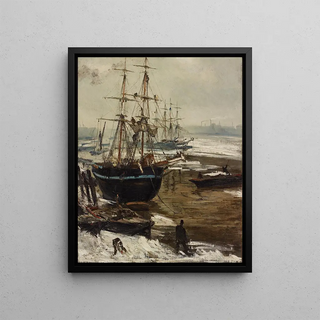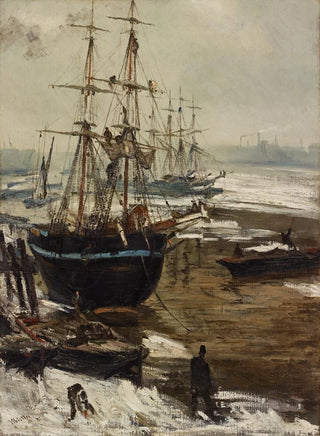Art print | The Thames Under the Ice - James Abbott McNeill Whistler


View from behind

Frame (optional)
In the world of art, certain works transcend their era to capture the imagination of future generations. "The Thames Under the Ice" by James Abbott McNeill Whistler is undoubtedly one of these iconic creations. Painted in 1860, this sublime artwork depicts a winter scene on the famous London river, frozen beneath a sheet of ice. Whistler, through this canvas, does not merely portray a landscape; he evokes an atmosphere, a sensation, a melancholy that still resonates today. The light, composition, and choice of colors intertwine to create a visual harmony that invites the viewer to a profound contemplation.
Style and uniqueness of the work
The uniqueness of "The Thames Under the Ice" lies in how Whistler plays with natural elements to create a scene that is both realistic and poetic. The shades of blue and gray, typical of the artist, evoke the biting cold of winter while offering emotional depth. The composition, with its flowing lines and delicate forms, guides the eye across the landscape, revealing subtle details that enrich the visual experience. Whistler does not merely aim to depict a frozen moment in time; he manages to capture the very essence of London winter, with its promises of solitude and ephemeral beauty. This work, through its impressionist approach, foreshadows the artistic movements that will follow, while remaining rooted in poetic realism.
The artist and his influence
James Abbott McNeill Whistler, a major figure of 19th-century art, knew how to leave his mark through his innovative approach and unique aesthetic. Influenced by his travels in Europe, especially in France, he developed a style that combines realism with impressionist sensitivity. Whistler always sought to express emotions through color and light, and "The Thames Under the Ice" is a perfect example. His work not only inspired his contemporaries but also paved the way for many modern artists. By blending technique with emotion, he redefined expectations related to landscape painting, inviting

Matte finish

View from behind

Frame (optional)
In the world of art, certain works transcend their era to capture the imagination of future generations. "The Thames Under the Ice" by James Abbott McNeill Whistler is undoubtedly one of these iconic creations. Painted in 1860, this sublime artwork depicts a winter scene on the famous London river, frozen beneath a sheet of ice. Whistler, through this canvas, does not merely portray a landscape; he evokes an atmosphere, a sensation, a melancholy that still resonates today. The light, composition, and choice of colors intertwine to create a visual harmony that invites the viewer to a profound contemplation.
Style and uniqueness of the work
The uniqueness of "The Thames Under the Ice" lies in how Whistler plays with natural elements to create a scene that is both realistic and poetic. The shades of blue and gray, typical of the artist, evoke the biting cold of winter while offering emotional depth. The composition, with its flowing lines and delicate forms, guides the eye across the landscape, revealing subtle details that enrich the visual experience. Whistler does not merely aim to depict a frozen moment in time; he manages to capture the very essence of London winter, with its promises of solitude and ephemeral beauty. This work, through its impressionist approach, foreshadows the artistic movements that will follow, while remaining rooted in poetic realism.
The artist and his influence
James Abbott McNeill Whistler, a major figure of 19th-century art, knew how to leave his mark through his innovative approach and unique aesthetic. Influenced by his travels in Europe, especially in France, he developed a style that combines realism with impressionist sensitivity. Whistler always sought to express emotions through color and light, and "The Thames Under the Ice" is a perfect example. His work not only inspired his contemporaries but also paved the way for many modern artists. By blending technique with emotion, he redefined expectations related to landscape painting, inviting






